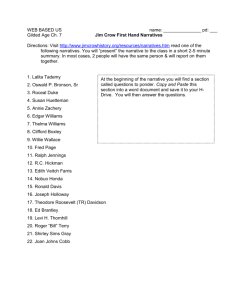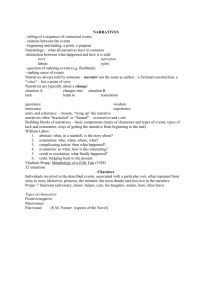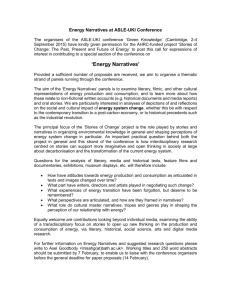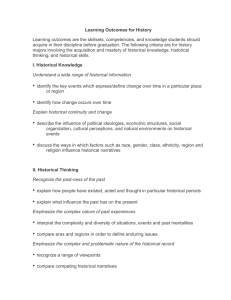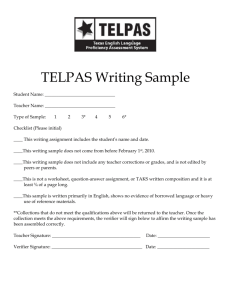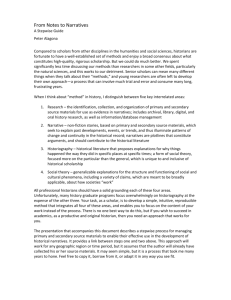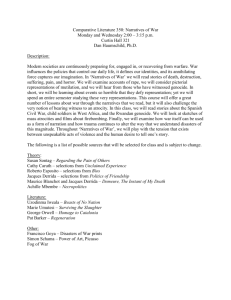Slides from April 11
advertisement
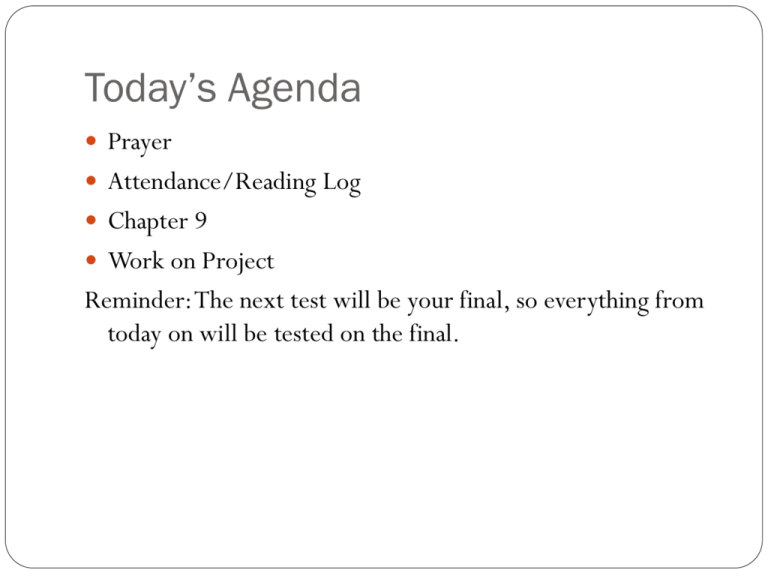
Today’s Agenda Prayer Attendance/Reading Log Chapter 9 Work on Project Reminder: The next test will be your final, so everything from today on will be tested on the final. Chapter 9: Genres of the OT Narratives The purpose of the biblical writers was more to instruct than to inform; more to teach later generations about Godhonoring conduct than to make sure they have the facts straight. Historical accuracy was not their top priority. Narratives Reports A brief, self-contained narration, usually in third-person style, about a single event or situation in the past. Anecdote – a report that details an event or experience in the life of a person. Battle report – recounts a military clash between opposing forces and its outcome, whether of victory or defeat. Construction Report – recounts the construction of important buildings or objects and describes their size, materials, and decoration in great detail. Dream report – details an individual’s experience of a dream. Epiphany report – reports and experience in which God or the angel of the Lord appears to someone, often to convey a message. Historical stories – written with more literary elaboration than an ordinary report. Develop a rudimentary plot, record dialogues and speeches by characters, and include dramatic literary touches. History – a lengthy document that focuses on a particular subject or historical era. Memoir – written in first-person, a memoir reports incidents in an individual’s life in order to portray the history, not of the writer, but of the era in which he or she lived. Narratives Interpreting Reports 1. Focus on the main subject and how it contributes to the themes of the larger context. 2. Readers must deduce their theological themes from the larger context that surrounds them unless God is participating in the report (e.g., dream reports, epiphany reports). 3. Reports make their points indirectly, therefore the reader must ask: What is this text trying to say? What subtle signals has the writer woven into the account to convey the message? 4. Find the theme. The reader must analyze the emphases of the individual reports to see what they share in common. Narratives Heroic Narrative A series of episodes that focus on the life and exploits of a hero whom people later consider significant enough to remember. Epic – tells of the heroic exploits of a virtuous hero. Two unique traits set it apart: its greater length and its magnification of the hero’s exploits to a greater scale of importance. Displays a strong nationalistic interest with the hero representing the destiny of a whole nation. Genesis 1-11 offers a cosmic epic because it narrates the formative story, not just of a nation, but of the cosmos and its human inhabitants. Genesis 12-36 offers an ancestral epic because it shows nationalistic themes – the destiny of Israel and her ownership of the land of Canaan. Narratives Prophet Story Recounts events in the life of a prophet, particularly those that demonstrate virtues worthy of emulation and, more importantly, that theologically critique the world in which the story’s readers lived. Two-fold purpose: to edify its audience by presenting the prophet as a model of proper conduct To discredit the larger politico-religious system for its denial of Yahweh as sovereign Lord Narratives Interpreting Heroic Narratives and Prophet Stories 1. Focus on the life of the main character. How does the hero’s life model a relationship with God and with other people? What aspects of the original reader’s worldview does it seek to critique or discredit? 2. Heroes portray values, therefore we must ask what values a given hero represents and how do those values challenge and seek to reshape the values dominant in the biblical and modern worlds? 3. Find the large themes. 4. Application of these narratives should focus on the analogous situations between Israel and the Church. Narratives Comedy A narrative whose plot has a happy ending, in some cases through a dramatic reversal. Interpreting a comedy: 1. Trace how tragedy turns to triumph. 2. Give attention to character development. 3. Discern the comedy’s main theme. 4. Application follows from the comedy’s main themes. Narratives Farewell Speech An address in the first-person voice reportedly given by someone shortly before his or her death. Interpreting a farewell speech: 1. Determine what makes the occasion of the speech historically pivotal. Why did the speaker give the speech? What surrounding circumstances or pressing issues lie in the background? 2. Summarize the speaker’s main point in a brief sentence. What does the aging leader urge his audience to do about it? 3. Decide what a given speech contributes to the themes of the larger context. 4. Look for application from the speech’s momentous historical setting and its main point. Narratives Embedded Genres Popular proverb – a pithy, well-known saying that comments on everyday people and events. Riddle – a simple statement whose hidden meaning must be discovered. Fable - teaches moral truths through brief stories in which plants and animals behave like people. Parable – a brief story with common human characters that illustrates an important truth. Songs – singing played a significant role in Israel’s daily life. Lists – a recounting of names or items whose shared characteristics allow their logical categorization. Narratives Interpreting Embedded Genres: 1. Usually, an embedded genre forms a component of a larger context rather than an independent context itself. 2. Thus, the goal of interpretation is to find what the component contributes to the message of the whole. 3. To attain that goal: 1. 2. 3. Define the main point of the embedded genre Define the main idea of its surrounding context Analyze the relationship between the point of the embedded genre and the idea of its context Law Types of Old Testament Legal Material Casuistic Law – recognized by its distinctive “if… then” grammatical structure and impersonal third-person style. The “if ” clause describes the case concerned, the “then” clause describes the legal penalty for infractions. Apodictic Law – laws declared in unconditional, categorical directives such as commands and prohibitions. Prohibition – negative command (“You shall not murder”) Admonition – positive command (“Honor your father and mother”) Legal Series – a text with a small number of laws phrased in a similar style Legal Instruction Priestly instruction – aims to instruct priests in professional matters such as ritual procedures Ritual instruction – instruction for laypeople about how to perform rituals properly Law Interpreting the Law 1. The collection or series in which an individual law appears serves as its literary context. Therefore, investigate surrounding laws for interpretive clues. 2. Try to understand the original meaning of laws in light of your cultural background. 3. Apply laws primarily to the NT counterpart of the original audience. Law Deuteronomy Represents a collection of laws, yet as a unique literary genre, it requires special consideration. Offers a comprehensive restatement of Mosaic Law. Parenesis – a style of speech that intends to persuade the audience to adopt a certain course of action. Law Interpreting Deuteronomy 1. Deuteronomy is best heard as Moses’ impassioned speeches to God’s people threatened by temptations to compromise their exclusive commitment to God. 2. Its crucial historical background is the potential, corrupting influence of the Canaanite religion on Israel. 3. Approach the laws of Deuteronomy as Moses’ passionate exhortations rather than as abstract, technical legal instruction. 4. The literary nature of each section should dictate the interpretive approach for it. Next Class Read IBI pgs 351-386 Reflection 11 due Saturday 11:59pm Interpretive questions DUE! We’ll complete Ch 9 covering Poetry, Prophecy and Wisdom Literature next class. If you have any questions, comments, or prayer requests, email/call/text. Notes will be posted from this class. Visit www.hollyjoy.com for latest post and to subscribe to posts. All previous documents can be found on Resources page.

